For this contest, you need to divide the players into two teams (or more - if there are too many players). Each team becomes in a circle. One of the participants in each team is solemnly awarded an ice cube. At the signal of the leader, the players begin to pass the ice in a circle at the fastest possible pace. The piece of ice should not stay in one hand for a long time! The team that breaks the ice first is the winner.
Possible different variants this game. You can just give each team (or each player if the company is small) a piece of ice and they will have to melt it as quickly as possible with any accessible way(the only condition is not to use batteries and any other heating devices, as well as sources of fire). To make the game go more dynamically, you can put cheerful cheerful music as a background.
Tangerine Courier
One of the symbols of the New Year is a round red tangerine. Using these citrus fruits, you can spend a lot funny contests. One of them is the Tangerine Courier contest.
The leader divides the players into two teams. Each team gets a chair with a tray full of tangerines. On the opposite side of the room there is an empty chair with a tray for each team (the distance must be the same for all participants). This game is a relay race. At the signal of the leader, the first member of each team must transfer one tangerine to an empty tray without the help of hands. As soon as he does this (or does not do it, dropping the tangerine on the way) and returns to the team, starts next member. The first team to transfer all the tangerines to their empty tray wins.
ice sculptures
Participants are divided into pairs. The host calls a letter, and each pair must quickly build a sculpture out of themselves, the name of which will begin with the named letter and have something to do with the New Year. The pair that completed the task last or did not cope with it at all is eliminated from the game. The host calls the letters until the winning pair is determined.
Snowball game
For this competition, you need to prepare in advance as many "snowballs" as possible - crumpled napkins, newspapers or just sheets of paper - and chairs according to the number of participants. The players are divided into two teams, which line up opposite each other on chairs. Each team selects a "sniper". He receives snowballs and starts throwing them at the players of the opposite team, and they, in turn, must dodge the "projectiles". The host counts the number of hits. Through certain time teams change places. The team whose "sniper" hit the most opponents with snowballs in the allotted time period wins.
The hard way to the tree
This competition is no longer team, but single. For this game you need a fairly spacious room in which to stand Christmas tree. A prize is placed along the Christmas tree, to which several intersecting "paths" are drawn, drawn on the floor with colored crayons. The more complex and longer the paths, the more they intertwine - the better. At the beginning of each path, you need to put a card on which the ways of moving along the “path” will be written - squatting, crawling, jumping on one leg, back forward, without the help of legs, etc. Each player must choose a “path” for himself (naturally without seeing what is written on the card). At the signal of the leader, the players begin to move along a given route. in a certain way. The one who managed to finish first is considered the winner and takes the prize from under the tree.
New Year's artists
This contest requires a minimum of eight people. Players are divided into two equal teams, which become a column in the back of the head to each other. The leader hands a pen (or felt-tip pen) and paper to the first person in each column, and shows the last player a picture with new year story(it should not be too complicated, but not too simple). At the signal of the leader, the last player in each team draws with his finger on his back in front standing player the picture they saw. This "pattern" is passed forward in a relay race, becoming more and more distorted with each player. The task of the first person in each column is to reproduce the drawing that has come down to him on paper. The team whose image is closest to the original wins.
This article gives examples of outdoor games for older teenagers. school age. These games allow you to make physical education classes more interesting and richer, allow you to attract a large number of people and do not require long training.
Mobile games are widely used in the classroom physical education in children's preschool institutions and in primary school. As children grow older, outdoor games are replaced by sports games, which imply that the child has certain motor skills and abilities.
And yet, the role of outdoor play, even for adolescents aged 16-18, can hardly be overestimated. Without requiring special motor skills, such games make it possible to achieve high motor activity of a large group of students, provide a high density of classes and an increased emotional background.
In a mobile game, objective results are achieved: the development of dexterity, quickness and speed of reaction, the improvement of coordination abilities, the development of the respiratory and cardiovascular systems of the body, as well as metasubject results: formation of the ability to communicate in competitive activities, the ability to control and evaluate one's own motor actions, feelings of collectivism, camaraderie, responsibility, etc.
In the process of an outdoor game, the creativity of children and adolescents is trained, that is, the ability to create something new, previously unknown, and personal qualities allowing them to act spontaneously in the current situation.
An outdoor game can be included in the running part of the warm-up or at the end of the main part of the lesson.
Here are some games that may be of interest to teenagers aged 16-18.
Games that develop attention and speed qualities:
By whistle.
Students run in a column one after another around the hall, the distance is two steps, on the whistle - crouched-jumped up, we continue to run. We did it several times, we complicate the task: on the whistle - the same thing, two whistles - turn 180 degrees, run in the opposite direction. After a few times we complicate it further: one or two whistles - the same thing, three whistles - acceleration of three or four steps, reach the shoulder in front of the runner.
Third wheel.
Everyone famous game. Students stand in a circle in pairs behind each other's heads. Around the circle, one runs away, the other catches up. At any moment, the evader and the chasing can exchange with those standing in a pair. If you stand in front of a couple, the one who stands behind runs. If you stand behind the pair, the player standing in front of the game runs.
Seine.
One player is a fisherman, the rest are fish. The fisherman is chasing the fish. Whom he caught up with, he becomes part of the seine, takes hands with the fisherman, and then you need to catch it together, do not disengage your hands, then the three of us, and so on, until all the fish fall into the seine. You can play for the whole room or limit the area where the participants are located, depending on the number of players.
Ball games:
Shootout.
This game is a kind of dodgeball, but on teams. The players are divided into two teams. Each team has its own field. Teams line up facing each other. Each team chooses a captain who is behind the field of the opposing team. The game is played with a medium-sized, medium-hard ball, a volleyball or rubber ball is suitable. The task of the players of the team in possession of the ball is to knock out all the players of the other team from the field. A ball hit from the ground does not count. The task of the players of the team not in possession of the ball is to intercept the ball in order to knock out opponents. To do this, you need to catch the ball on the fly, or pick it up from the ground in your field, or pick it up if you knocked out a teammate. Players who are knocked out do not drop out of the game, but go beyond the opponent's field to help their captain. When all the players of the team are knocked out, the captain enters the field, the ball goes to the captain, the game continues. The team that manages to knock out the captain from the field before the opponents wins.
Shootout - sometimes also called "Sniper", perhaps the most favorite game for children different ages. Very gambling, fostering a sense of camaraderie and team spirit, this game contributes to the development of speed-strength and coordination abilities.
Ten passes.
The players are divided into two teams. The game is played with a volleyball or basketball. The game is similar to "Birds - Dogs", only on teams. The task of each team is to make ten passes within the team without losing the ball. If the ball is in the possession of the players of the other team, it must be intercepted and a count of ten passes must begin.
This game is also very gambling, it teaches the interaction of players with each other, it is a simulator for practicing basketball passes.
Tactical games:
Glove.
The name of the game is conditional, we use a glove as a prop, but you can take any medium-sized object, for example, a baton or a flag. Players are divided into pairs, preferably by speed, each pair receives a number in order. The couples stand opposite each other different sides sites. In the center of the site is a glove. The teacher calls the number of the pair out loud. The players both run up to the glove. The task is to take away the glove so that the opponent does not taunt you. For this, various distracting tricks are taken, a convenient moment is chosen, and so on.
This game is not very dense, but requires tactical thinking and high attention from the players.
Stolen banner.
The players are divided into two teams. In the middle of the hall is a line separating the fields of each team. At the opposite end of the field from the line, each team has a hoop or circle made from a rope. There is a banner in the circle. It could be a glove, or a flag, or a baton. The task of each of the teams is to get to the banner and be the first to bring it to their territory. A player of the opposing team can pin down a "scout" on his territory, and he loses the ability to move until he is pinned down by a player of his team. You can stay inside the hoop for any amount of time, this is the "embassy" of the team on the opponent's field.
Players different teams can, by agreement, be drawn with each other across the middle line. If a player drags an opponent to his territory, he is considered to be stung and does not move until a friend saves him.
Several people from the team can run into the hoop. It is allowed to hide the banner behind the back, but not under the clothes. Players perform various tactical tricks to take out the banner, for example, one player runs on right side platforms, the other - on the left, and the third - through the center. Who has the flag is unknown.
This game does not involve great physical effort, and also takes a significant amount of time. But she is very reckless, develops tactical thinking, suggests a high degree creativity and develop team spirit.
Hello everyone! Evgenia Klimkovich is in touch.
Last Sunday, my older children, son Denis, who is already 19 years old, and daughter Alexandra, who will soon be 11, attended one exciting event. They returned home satisfied and told me about new interesting games for teenagers, which they learned at this event.
But first, I will briefly talk about the event itself and where it took place.
Lesson plan:
Fujiyama Club

So, we have a Fujiyama club in Lipetsk. There, children are taught various martial arts, dances, chess and other interesting things. In this club I enrolled my younger son Artem, he goes to aikido. Denis looked at Artyom and also wanted to take up this sport. So now we have two aikido beginners in our family)
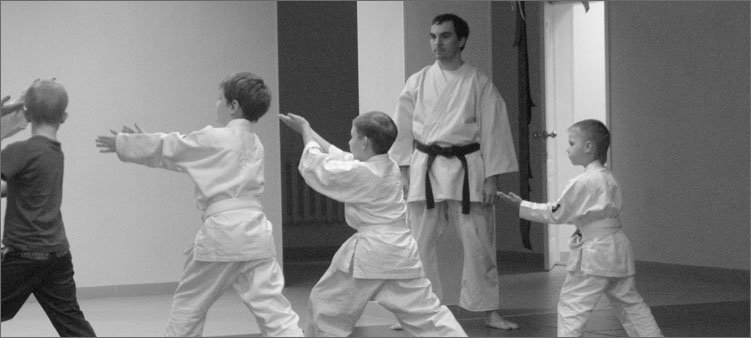
And once, the administrator of the club Anna told me that on the basis of the club it is planned to open the School of Leaders. I immediately thought about my Sasha, as this is exactly what she (with her indefatigable energy and desire to organize everyone) needs.
And so, on this Sunday, Fujiyama arranged a day open doors. Where everyone who wanted to attend the "School of Leaders" could learn more about what it is. The children came with their parents. I was at work, so my kids went there on their own.
For adults, a meeting was arranged with a psychologist who talked about how to properly communicate with children, how to help them in their studies, about other important things and answered questions of interest.
![]()
Well, the kids, mostly aged 10 and older, went to the next room with their instructor Petya in order to get to know each other and learn new things. interesting games.

As far as I understood, the games were selected taking into account the fact that this is still the “School of Leaders”. Each of them is aimed at developing a certain skill that will certainly come in handy in the life of any person, and especially a leader. In two hours we managed to play seven games, which I want to present to you.
Game-acquaintance
I knew about this game for a long time, we did something similar at weddings, when we were still working in our holiday agency, in order to reacquaint all the guests. But I liked the version of the game presented in Fujiyama more.
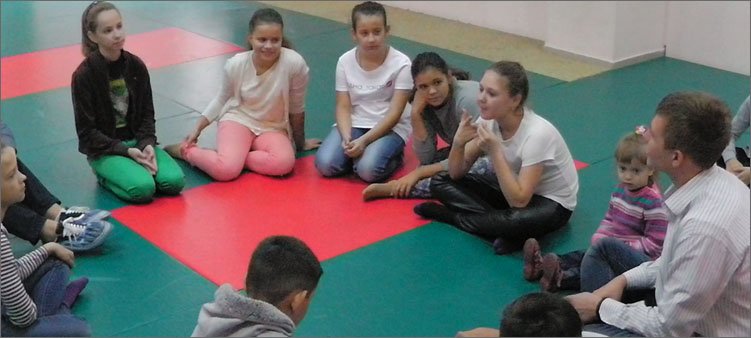
Everyone sits in a circle. The first participant begins to talk about himself. For example,
"My name is Sasha. I am land. I am 10 years old. I'm in the 5th grade. I like to dance and travel and don't like to draw."
What is land here? And despite the fact that you definitely need to come up with an adjective to yourself, starting with the same letter as your name. The word "land" came to Sasha's mind first, so she said it. I think it's very original
The task of the next player is to once again briefly introduce the previous player and then tell about himself. Again, an example, after Sasha, a girl Katya was sitting in a circle. So Katya says:
“This is Sasha. She is land. And my name is Katya. I am beautifull. I am 11 years old. I'm into singing"
The third person in the circle represents the two people sitting before him, and then himself. For example,
“This is Sasha. She is land. This is Katya. She's beautiful. And my name is Yana. I am bright, I am 10 years old, etc.”
That is, each subsequent person represents all the previous ones and then himself.
During this game, remembering the names of all the participants is not a problem. I think that adjectives are used in the game not by chance, they also include figurative memory in the memorization process.
Zib. Zeb. Zab.
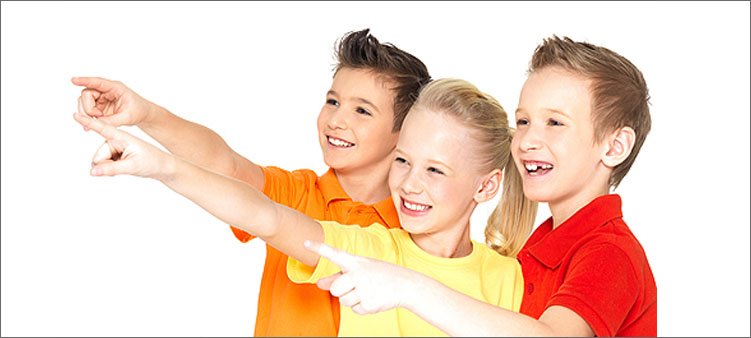
I heard about this game for the first time from my children, I have never played it before. This fun contributes to the development of speed of reaction and observation.
Again, the players stand in a circle.
The first player abruptly throws his hand in front, pointing to someone standing in a circle and loudly says: "Zib!"
The player pointed at by player number one also throws his hand forward sharply, points to someone else and says the word "Zeb!"
This third player again points at someone with a sharp outstretched hand and says: “Zab!”
I found this game to be very simple. But Alexandra said that everything is not so simple as it seems. Firstly, you can gape and not notice that they pointed to you. And secondly, it is possible (and this happened often) to say instead of "Zib", for example, "Zab", that is, to stray from the row. Whoever this happens to is out of the game.
Where is the coin?

A game aimed at the development of observation. So, all players stand in a circle and join their palms in this way.
The right palm rests on the left palm of the player standing on the right, and on the left palm of the player lies right palm the player on the left.
If you don't understand the previous sentence, try rereading it one or two more times.)
First, the host goes out the door, and one of the players takes a coin in his hand and hides it in his palm. When the host returns, the participants in the game begin to pass the coin to each other in a clockwise direction. From hand to hand. From palm to palm. The task of the presenter is to determine who is in the hands of this moment there is a coin.
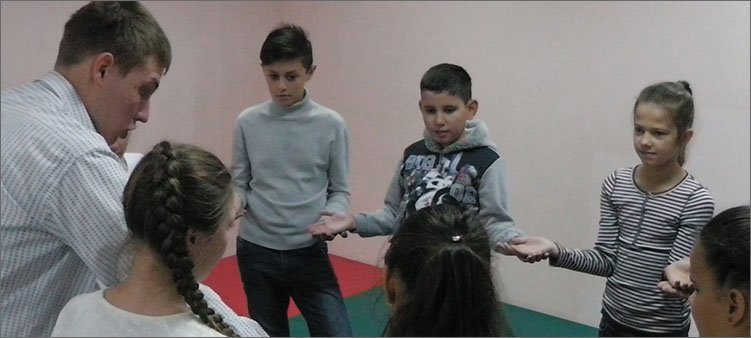
Everything would be very simple, if not for one thing. The fact is that the movement of the hands is made not only by the one who has the coin at the moment, but in general by all participants. That is, it seems that each player has a coin and they all pass these coins to the neighbor on the left.
If the leader determines the correct holder of the coin, then this player becomes the leader, and the leader becomes in a circle.
Frog
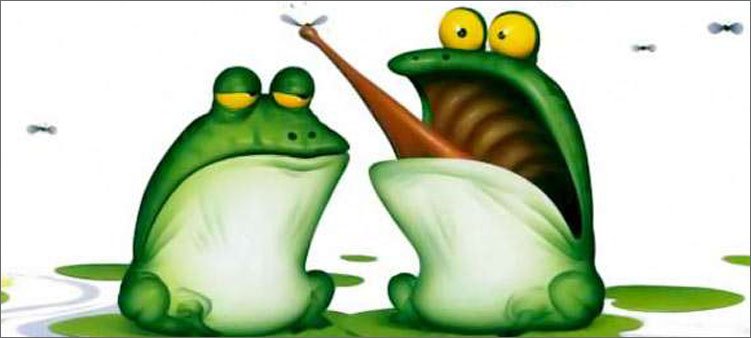
This game is somewhat similar to the previous one. Everyone is standing in a circle. The leader goes out the door. The players, while there is no leader, agree on which of them will be the “frog”. The leader returns and stands in the center of the circle. His task is to determine who is appointed to the role of "frog".
What is the frog doing? The frog shows its tongue (sticks out and puts it back). But he does this only when the leader does not look at her, for example, when he turns his back to the “frog”. Well, when the one who drives turns to face the “frog”, then she tries not to give herself away.
It happens that the leader turns at the very moment when the “frog” has not yet had time to hide his tongue. It happens that the “frog” is given out by the views of other participants in the game who are looking at it. So here the host needs to be very careful and learn to read faces, the "frog" needs to be careful not to get caught, but the rest of the players need to remain calm.
Wampum
Do you know what wampum is?
Wumpum are cylindrical beads strung on cords that served North American Indians for various purposes.
well, now you know)

The role of wampums was played by small pieces of paper that were tied to strings and worn around the neck of the players.
Everyone is divided into two teams. And on a signal, they begin to play. The task is simple. Rip wampums from your opponents and prevent them from plucking their wampums. The team with the last player left with the wampum around their neck wins.

If you think about it, it becomes clear that you can win this game if you develop cunning team tactics and choose one of your players, who will be protected by everyone else from the attacks of the opposing team, while trying to rip wampums from rivals.
But it's hard to understand at first glance. So everyone acted alone. As a result, Sashulya lost her first wampum) By the way, there is a small piece of video from this outdoor game.
Find your match
In order to play this game, you need to split into pairs. Each pair comes up with a phrase. For example, Sasha and the boy with whom she was paired came up with "Old Man Hottabych". Sasha had the word "old man", the boy - "Hottabych". Everyone closes their eyes. The leader of the game separates the pairs. Just takes one of the players somewhere away from the second.
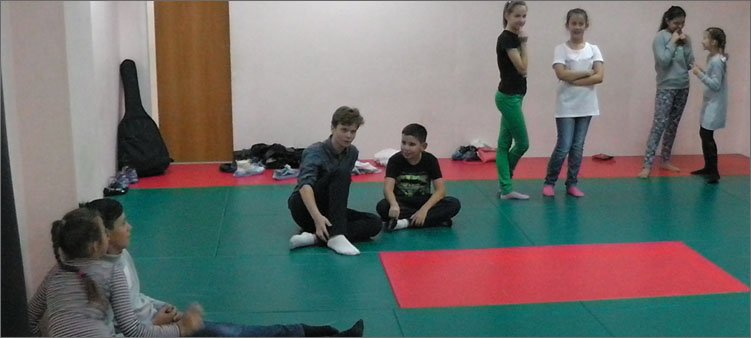
And then, at the signal, the couples should try to connect. It's just that you can't open your eyes. You need to shout out your word loudly and try to hear the word of your partner and follow this call. It's probably cool when 20 people scream in the hall, each loudly and each with his own word.
line up

And another game very similar to the previous one. The children line up. The facilitator chooses some proverb, rhyme or tongue twister and distributes the words among the participants in turn. Let me explain with an example.
The tongue twister "Sasha walked along the highway and sucked dry" was used. The first player gets the word “went”, the second “Sasha”, the third “by”, etc.
Then the players close their eyes and the leader stirs them. The task of the players on a signal from eyes closed line up in the correct order by shouting out your words and focusing on the words that others are shouting out.
That is, the second person in the row must find and stand between the players shouting “go” and “on”.
These are some great games! I think that it will be interesting to play them for kids not very small. Class from the third, fourth. And high school students will love them too. Yes, what is there, and adults would not mind playing in them. Do you agree?

They can be done both indoors and outdoors. They are ideal for organizing teenagers' leisure activities at a summer camp. They will become interesting entertainment for a birthday. Moreover, both boys and girls will like it.
That's all for today. I hope you were interested) Try to gather a company and play these games with your children.
Leave comments are allowed)
Always yours, Evgenia Klimkovich.
Physical education lessons in 7th - 9th grades are different from those that were held in elementary school. There are no longer those entertaining themed games, classes are increasingly taking sports character are being held.
Since with intensive growth in adolescence the body's need for oxygen increases, this leads to an increase in the vital capacity of the lungs. To help the body cope with such a load, they resort to the help of outdoor games for teenagers, based on doing energetic manipulations. This contributes to the development of calm and economical breathing.
Interesting outdoor games for teenagers
Fifteen gear game
The rules of the game require a medicine ball weighing at least 5kg. Plays several teams with 3 players. Each participant is assigned No. 1, 2 or 3. All teams line up, keeping a distance of at least 7 or 8 between themselves.
The ball at the start is at the center player (No. 2). The leader gives a signal, player #2 throws the ball to player #1, who, in turn, to player #3. One lap, one pass. Behind a certain amount of time to complete 15 such transfers. If the ball falls from the hands, the count starts over. The team that manages to complete the maximum number of passes in a certain period of time wins. According to the rules of the game, after each round, that is, a cycle, the central player loudly announces serial number transmission (shouts out so that the rest of the participants can hear).
Outdoor games for teenagers are with a ball, which can be considered as a transitional step to sports, and team games, where players are differentiated into "defenders" and "forwards". Here, teenagers are already trying to form a permanent team, which allows them to positively solve technical problems. Outdoor games for teenagers are more organized, because they themselves monitor the strict observance of the rules of the game, and the teacher's comments are practically reduced to zero.
: game examples
Game "Across the net with 2 balls."
The game must be played on the volleyball court. It is not necessary to have a volleyball net at the same time, it is enough to pull a rope or a rope. Children are divided into 2 teams with an equal number of participants. Each team stands on opposite sides of the field in 2 or 3 rows. Each has one ball.
The whistle of the leader serves as the beginning of the game. After the signal, the throwing of balls to opposite sides begins, the action continues until 2 balls are on one side at the same time. At the same time, the leader blows a whistle, the game stops, the team on whose side there were no balls gets a point. And so on until one of the teams scores 10 victory points. It is necessary to ensure that the ball does not fly under the net, does not fall, does not collide with another ball in flight. If this happens, the submission is made again. In case of violation of the rules of the game by one of the teams, penalties are counted to it.
Game "Be able to catch up"
The game is played in a spacious hall, not cluttered with inventory. At all 4 corners, racks are placed at a distance of 3-4 m from the corner itself. Along the perimeter of the hall, near the walls, the boys are located at an equal distance from each other, turning to the wall with their right side.
The beginning of the game is the command of the leader "March". Here the race begins: the boys run counterclockwise, running around the racks, trying to catch up and hit the running player in front, while not allowing themselves to be caught up behind the walking one. The 3 most enduring players who were never caught win the competition.
The main rule of the game is the division into a team of boys and a team of girls who compete separately from each other.
Psychological games and exercises for teenagers
Team building games
Clock face
Description
Participants sitting in a circle form a "clock face" - each of them corresponds to a certain number. The easiest way is if there are 12 participants - then one number corresponds to each. With a different number of players, someone will have to represent 2 numbers, or, conversely, there will be 2 people for any numbers. This will complicate the game somewhat, but also make it more interesting. If there are more than 18 participants, then it is advisable to make 2 dials at once. After that, someone orders the time, and the “dial” shows it - first, the one whose digit had the hour hand, then the minute one, gets up and claps his hands. The leader can make the first 1-2 orders of time, then each of the participants in a circle.
The meaning of the exercise
Attention training, the inclusion of participants in active group interaction.
Discussion
A brief exchange of impressions, as well as considerations about what qualities are developed in this game and what they are for.
Cotton on the knees
Description
Participants, sitting in a circle, place their hands on the knees of their neighbors in such a way that right hand each was on the left knee of the neighbor on the right, and the left - on the right knee of the neighbor on the left. After that, they are invited to count in a circle clockwise in such a way that the numbers are pronounced in the order corresponding to the location of the hands on their knees: the one who starts says “one”, the neighbor on the right says “two” (since his hand lies in the order of the next ), the neighbor on the left is “three”, and “four” is again the one who started the count, etc. Whoever made a mistake is out of the game. The counting continues until about half of the players are out of the game. As a complication, you can ask participants to count backwards or add or subtract one from each subsequent number.
The meaning of the exercise
The exercise serves as a good intellectual warm-up, develops mindfulness, creates conditions for observing communication partners.
Discussion
A long discussion is not required, a short exchange of impressions is enough.
rock climber
Description
Participants stand in a tight line, creating a "rock" on which protrusions ("snags") stick out, formed from the exposed arms and legs of the participants, bodies tilted forward. The driver’s task is to walk along this “rock” without falling into the “chasm”, that is, without putting his foot outside the line formed by the feet of the other participants. The driver himself chooses a way to solve this problem. You can't talk. It is most convenient to organize the exercise in the form of a chain - participants from one end of the "rock" alternately make their way to the other, where they again "embed" into it.
The meaning of the exercise
Formation of trust, breaking of spatial and psychological barriers between participants. In addition, the exercise works to develop skills non-verbal communication(communication without
the power of words through gestures, facial expressions, etc.) and the coordination of joint actions. Physical and emotional warm-up.
Discussion
Exchange of emotions that have arisen during the game. What feelings did the leaders and the components of the “rock” have when performing this exercise? What helped and what hindered the task?
living mirror
Description
Participants are grouped into threes. The music turns on, and one person from each trio begins to make any movements that he wants to it. Two other participants act as a "living mirror" - they repeat all his movements (1.5-2 minutes).
Then the roles are reversed so that active position visited by each of the participants.
The meaning of the exercise
Warm-up, rallying, creating conditions for a more complete understanding and getting feedback- the ability to look at your movements "from the outside", through the eyes of other people.
Discussion
What emotions and feelings arose during the exercise? What new did you manage to learn about yourself and about those with whom you were in the top three?
magic key
Preparation
For the exercise you will need a lock key and a long thin rope (the length is determined at the rate of 1.5 m per participant).
Description
Participants sitting in a circle are given a lock key to which a long rope is tied, and it is proposed to pass this rope under the clothes of each of the participants so that it enters under the clothes from above, at the level of the collar, and exits from below, at the level of the belt. Thus, the whole group is connected. Then you can invite the participants to collectively perform several simple exercise(get up, lean forward, sit down, etc.).
When the exercise is completed, it is advisable to leave the key in the field of view of the participants as a kind of symbol of the group: “With the help of this key, we were connected by one thread. Let it hang in a conspicuous place and remind us that now we are one team.
The meaning of the exercise
Team building, which is largely symbolic (“we are now connected by one thread”). Removal of spatial and psychological barriers between participants.
Discussion
Exchange of emotions that arose during the exercise, and also considerations in which life situations the participants dig in "tied together by a single thread".
Effective Communication Exercises
relay race with balls
Preparation
Four inflated balloons(better if there are also a few spares).
Description
Participants are divided into 3-4 equal teams, including an even number of participants (for the possibility of working in bunk beds). There is a relay race in between the following rules: the first pair from each team gets balloon, with which she must go along the distance (6-10 m), hit them on the intended target (approximately 50 x 50 cm) and return back. At the same time, you cannot take the ball in your hands, it must be in the air all the time, and partners are allowed to touch it strictly alternately. Then the ball is passed to the next pair from his team, and so on, until he visits each pair. The team that completes the relay faster wins. As a variant of the exercise, the ball is clamped by two participants between themselves in any way, it is forbidden to touch it with your hands. The pair that dropped the ball starts from the beginning of the race.
The meaning of the exercise
Establishing mutual understanding in pairs. Developing the ability to act in a coordinated manner with partners, quickly, decisively and deftly.
Discussion
What emotions arose during the game? What qualities, besides dexterity, are required to achieve victory in such a relay race? Where else are these qualities needed?
Nonsense
Description
Each participant receives a sheet of paper and writes on it the answer to the presenter's question, after which he folds the sheet so that his answer is not visible, and passes it on to his right neighbor. He answers the next question of the host in writing, folds the sheet again, passes it on, etc. When the questions are over, each participant
unfolds the sheet in his hands, and aloud, like a coherent text, reads the answers written on it.
Sample list of questions:
Who?
Where?
With whom?
What did you do?
How did it happen?
What do you remember?
And what happened in the end?
The meaning of the exercise
Outwardly, the exercise resembles a joke, but the resulting texts sometimes turn out to be quite unexpected and make you think about the problems that are significant for the participants.
Discussion
There is usually no need to discuss this procedure in detail. It is enough to ask the participants to express which of the resulting texts seemed to them the most interesting and why.
Group Spmpathy
Description
Each of the participants gets a minute of time to speak to the group. The performance takes place in free form- it can be oral speech, small acting role, demonstration of any sports skills, etc. Only one task is set - to arouse the sympathy of the group with the help of this performance. Then each participant evaluates the performances with points from 1 to 5, describing how much the participant aroused his sympathy.
This is done in writing, on small pieces of paper. When all performances are completed, the facilitator collects these sheets and calculates the amount of points scored by each speaker, and names 3-5 participants who scored highest score. It is not recommended to fully voice the list, as this may be uncomfortable; for participants who scored insufficiently high scores.
The meaning of the exercise
Training of self-presentation skills, development of speech competence, training of quick wits. Material for discussion, what are our likes and dislikes in a relationship.
Discussion
What is the meaning of the word "sympathy"? What do the most highly rated performances have in common?
Guess the rhyme
Description
The participants are divided into two teams. The host pronounces a word from among the common ones in Russian, to which it is easy to pick up a lot of rhymes (for example, you can use: house, nose, day, soup, ice, goal, may). One team comes up with three rhymes for him.
Their task is to demonstrate these rhymes to the other team in such a way that they can guess them. At the same time, it is impossible to speak or point at surrounding objects, you need to demonstrate words only with the help of facial expressions and gestures. Then the leader pronounces the next word, the teams change roles, and the game is repeated (total duration 4-6 rounds). There is no formal definition of winners in this game, but the players can be explained that the team that spends less time choosing rhymes and inventing how to demonstrate them, as well as those whose rhymes are more quickly guessed by opponents, is more effective.
The meaning of the exercise
Non-verbal expression develops (the ability to express one's thoughts and states through facial expressions and gestures, without the help of words), observation and the ability to understand interlocutors based on their facial expressions and gestures. Training fluency and flexibility in speaking (the ability to quickly select rhymes is closely related to these qualities).
Discussion
Who liked the role of inventing and demonstrating rhymes more, and who guessed why? What variants of the proposed rhymes and ways of demonstrating them were remembered, seemed the most interesting, what exactly? Why is it important to be able to convey certain information without the help of words, and also to understand such information transmitted by other people?
Gretsov A., Bedareva T. Psychological games for high school students and students









